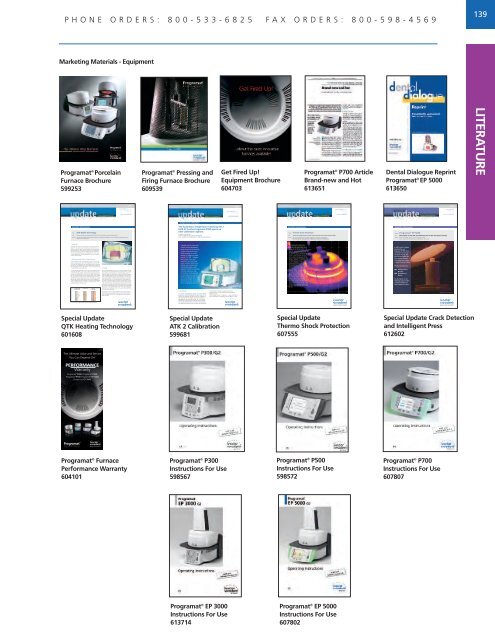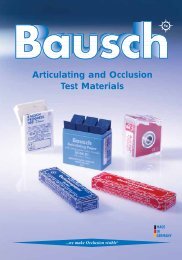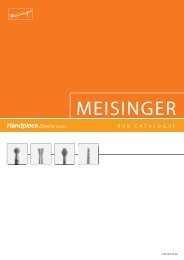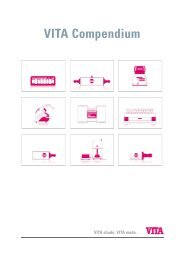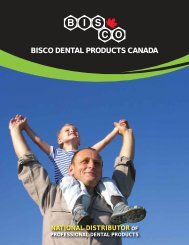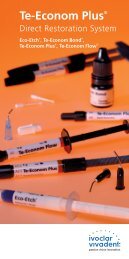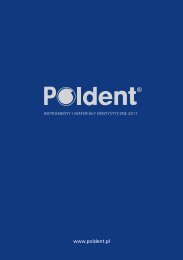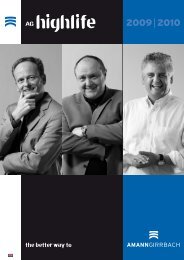Create successful ePaper yourself
Turn your PDF publications into a flip-book with our unique Google optimized e-Paper software.
1. Introduction<br />
Extremely high requirements are placed on heating elements. In<br />
addition to an excellent and homogeneous heat distribution for<br />
optimum sintering of dental ceramic materials, the heating elements<br />
should also feature a particularly long service life and reliable heating<br />
performance across the entire temperature range. Therefore, a<br />
new and extraordinarily powerful heating element, which meets<br />
all these requirements, has been developed for the new Programat<br />
furnaces P300 and P500.<br />
P O R C ELAIN FU RNAC E S<br />
Ivoclar Vivadent AG Technical<br />
Bendererstrasse 2<br />
FL-9494 Schaan<br />
Liechtenstein<br />
www.ivoclarvivadent.com<br />
Topic:<br />
Title: Scientific and furnace-related technical aspects of the new heating muffle technology (QTK)<br />
Author: Dipl.-Ing. (FH) Rudolf Jussel, Research Associate in Equipment Development, Ivoclar Vivadent AG, Bendererstrasse 2,<br />
9494 Schaan, Liechtenstein<br />
2. Differentiation and function of heating elements<br />
Ivoclar Vivadent AG uses the heating element types shown in Figure 1.<br />
Given the missing quartz sheath, the Programat furnaces P95, P80,<br />
P100, and P200 demonstrate a very direct heating effect. Furthermore,<br />
the heat does not develop evenly. The situation has been improved<br />
with the Programat PX1 heating element, in which the heating wire<br />
is guided through a quartz glass tube.<br />
3. Principle<br />
In a QTK heating element like the one used in the Programat P300 For a better understanding, the function of the quartz glass cylinder<br />
und Programat P500, a quartz glass cylinder has been placed in placed in front of the heating element is best described with a candle<br />
front of the heating element. The mass of this quartz glass cylinder as an example. If the temperature is measured directly above the<br />
provides two positive effects. Given the filter effect of the quartz flame of a candle, the measurement will show the highest temperature<br />
glass in the infrared range, the quartz glass cylinder itself is heated in the immediate vicinity of the flame. Only slightly to the side of the<br />
up. Subsequently, the temperature is evenly distributed to the firing flame, the measured temperature rapidly decreases. There exist steep<br />
chamber via the quartz glass cylinder. Since the quartz glass cylinder temperature gradients or temperature inhomogeneity, respectively,<br />
demonstrates thermal conductivity, the heat is evenly transported to within the flame. Now, if a thin metal plate that is clearly larger than<br />
all the involved heating coils and spirals. In this way, the corresponding the frame is held directly above the flame, the metal plate will very<br />
stress is equally distributed to the entire heating element, which evenly heat up due to the thermal conductivity of the metal. The heat<br />
positively influences the service life.<br />
is also given off laterally. A homogeneous temperature distribution<br />
occurs above the metal plate. A point source of heat is thus transformed<br />
into a large-area heat source. The same principle is also applied,<br />
for example, in a gas-powered barbecue grill, in which a localized gas<br />
flame heats up a metal plate, which, in turn, evenly distributes the heat<br />
Programat P95, Programat X1 Programat<br />
P80, P100, P200<br />
P300, P500<br />
to the items to be barbecued.<br />
The application of this principle coupled with the interplay of various<br />
other constructive parameters permitted to achieve a very homogeneous<br />
temperature field in the firing chamber of the Programat<br />
P300 and P500.<br />
Fig. 1: Cross-sections of different heating elements of Ivoclar Vivadent furnaces<br />
By Rudof Jussel (Dipl Ing)<br />
Scientific collaborator at Equipment Development,<br />
Ivoclar Vivadent AG, Bendererstrasse 2, 9494 Schaan/Liechtenstein<br />
In keeping with the current trend<br />
of dental materials development,<br />
ceramic furnaces for the fabrication<br />
of metal-ceramic and all-ceramic<br />
dental restorations are usually<br />
operated at a temperature range<br />
from 600 °C to 1000 °C. However,<br />
there has been a clear trend<br />
towards the use of low-fusing<br />
ceramic materials. Therefore, the<br />
challenge was to create a device<br />
which enabled highly accurate<br />
calibration of dental firing chambers<br />
in the low temperature range.<br />
This resulted in the development<br />
of a new temperature calibration<br />
aid for the Programat P500, which<br />
relies on the principles of the wellknown<br />
silver test, but is based on<br />
the use of high-purity aluminum.<br />
1. Introduction<br />
It is common knowledge that ceramic furnaces for dental<br />
applications need to be calibrated at regular intervals. This<br />
necessity for calibration has various causes, eg deposits in<br />
the firing chamber, the impact of chemical substances<br />
segregated by the processed material, etc A number of<br />
methods are currently used to calibrate furnaces Ideally,<br />
they should enable operators to conduct the calibration in<br />
their laboratory and allow them to adjust the temperature<br />
Ivoclar Vivadent AG Technical<br />
Bendererstrasse 2<br />
FL-9494 Schaan<br />
Principality of Liechtenstein<br />
www.ivoclarvivadent.com<br />
Fig. Programat P500<br />
in the furnace to that of the specifications of the<br />
manufacturer in a simple procedure that provides the<br />
desired accuracy.<br />
Unfortunately, the term “calibration” is used incorrectly by<br />
some manufacturers. Calibration does not refer to a mere<br />
Subject:<br />
Title: Control the closing process of ceramic furnaces with the Thermo Shock Protection (TSP)<br />
Author: Dipl.-Ing. (FH) Rudolf Jussel, scientific collaborator in Equipment Development<br />
Eidg. dipl. MDT Karl Gmür, dental lab collaborator in Research and Development<br />
Ivoclar Vivadent AG, Bendererstrasse 2, 9494 Schaan, Principality of Liechtenstein<br />
The drying and closing process<br />
represents the beginning of every<br />
firing cycle of dental ceramics. The<br />
basis for a good result is already laid<br />
at this point. Errors during drying<br />
result in unsatisfactory outcomes<br />
since a series of subsequent firing<br />
cycles is required. The product family<br />
of the Programat furnaces offers<br />
various possibilities to control the<br />
closing process. In case of the<br />
standard closing procedure, the<br />
furnace head is closed by means of a<br />
defined closing movement within a<br />
given time. Consequently, many<br />
things are left to chance. With the<br />
new Thermo Shock Protection (TSP)<br />
function, the standard closing<br />
process is actively controlled and<br />
chance is turned into control, similar<br />
to the antilock braking system (ABS)<br />
in cars.<br />
Ivoclar Vivadent AG Technical<br />
Bendererstrasse 2<br />
FL-9494 Schaan<br />
Liechtenstein<br />
www.ivoclarvivadent.com<br />
Fig.: Imape taken by means of a thermal imaging camera during the predrying process<br />
Title:<br />
Author: Robert Grünenfelder, project manager Programat EP 5000,<br />
Ivoclar Vivadent AG, Bendererstrasse 2, 9494 Schaan, Liechtenstein<br />
In 2007, Ivoclar Vivadent<br />
launched the new<br />
Programat EP 5000 press<br />
and ceramic furnace on<br />
the dental market. This<br />
press furnace offers two<br />
new technical features,<br />
which have been unique<br />
in dental furnaces to date.<br />
The new functions are:<br />
IPF Intelligent Press<br />
Function<br />
CDS Crack Detector<br />
System<br />
The description on the<br />
following pages provides<br />
a technical insight into<br />
these complex functions.<br />
Ivoclar Vivadent AG<br />
Bendererstrasse 2<br />
FL-9494 Schaan<br />
Liechtenstein<br />
www.ivoclarvivadent.com<br />
Open furnace head after the press cycle<br />
P H O N E O R D E R S : 8 0 0 - 5 3 3 - 6 8 2 5 F A X O R D E R S : 8 0 0 - 5 9 8 - 4 5 6 9<br />
139<br />
Marketing Materials - Equipment<br />
Programat ® Porcelain<br />
Furnace Brochure<br />
599253<br />
Programat ® Pressing and<br />
Firing Furnace Brochure<br />
609539<br />
Get Fired Up!<br />
Equipment Brochure<br />
604703<br />
Programat ® P700 Article<br />
Brand-new and Hot<br />
613651<br />
Dental Dialogue Reprint<br />
Programat ® EP 5000<br />
613650<br />
LITERATURE<br />
1/2006<br />
1/2005<br />
1/2007<br />
1/2008<br />
Temperature calibration<br />
Scientific Information<br />
QTK Muffle Technology<br />
The Automatic Temperature Checking Set 2<br />
(ATK 2) for the Programat P500 opens up<br />
new calibration options<br />
Scientific Information<br />
Thermo Shock Protection<br />
Scientific Information<br />
Subject: Programat ® EP 5000<br />
Description of the IPF and CDS function in the new press furnace<br />
Special Update<br />
QTK Heating Technology<br />
601608<br />
Special Update<br />
ATK 2 Calibration<br />
599681<br />
Special Update<br />
Thermo Shock Protection<br />
607555<br />
Special Update Crack Detection<br />
and Intelligent Press<br />
612602<br />
The Ultimate Value and Service<br />
You Can Depend On!<br />
PERFORMANCE<br />
Warranty<br />
Programat ® P300, Programat ® P500,<br />
Programat ® P700, Programat ® EP 3000,<br />
Programat ® EP 5000<br />
Programat ®<br />
Programat ® Furnace<br />
Performance Warranty<br />
604101<br />
Programat ® P300<br />
Instructions For Use<br />
598567<br />
Programat ® P500<br />
Instructions For Use<br />
598572<br />
Programat ® P700<br />
Instructions For Use<br />
607807<br />
Programat ® EP 3000<br />
Instructions For Use<br />
613714<br />
Programat ® EP 5000<br />
Instructions For Use<br />
607802


